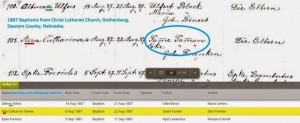[republished from the old blog of 10 May 2015]
It never dawned on me to think of it as a tilde. That’s probably because I knew what it meant and seeing no wiggle in the mark above the “n” told me there was no wiggle room in how that line should be interpreted. 
The diacritic did get transcribed over the letter “a” in Catharina. [Turns out this is not a diacritic.Follow up post coming.]
Learning various writing conventions and shorthand takes time. Understanding these conventions also requires some knowledge of local names so that these conventions can be interpreted correctly. I can’t overemphasize the importance of becoming familiar with the records being used and manually searching those records–even when indexes are available.
Have you thought about dropping the second double letter in a name when querying a database? Did the creator of the record you are using an index for use a notation that a transcriber handled incorrectly? These sorts of issues are not only encountered with church records written in the German script.
Note: Screen shorts of Ancestry.com screens are current as of the date this post is published.


2 Responses
[…] When Is It a Diacritic and When Is It Shorthand?, Rootdig […]
Hummm, that does now make sense in some of the names I’ve come across. Will write in both after I look up these new words, as I am not familiar with Diacritics or tilde. I like to learn something new every day. I will look them up in a regular dictionary.